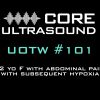A 29 year old female with history of Type 1 Diabetes presents with left eye pain. Patient has been having symptoms for the past two days with deep, burning left eye pain and copious watery discharge which worsened this morning. Patient has photophobia and blurry vision. On examination, she had moderate, diffuse conjunctival injection with watery discharge and photophobia with direct and consensual light testing.
Bedside Ultrasound reveals the following:
What is the most likely diagnosis?

Answer and Pearl: Posterior Scleritis
The bedside ultrasound images demonstrated a thickened posterior sclera with fluid in Sub-Tenon space and around the optic nerve. This is known as T sign and is pathognomonic for posterior scleritis. Fluid in sub-tenon space is shown by the cyan arrow in the following clip:
The patient required treatment with nonsteroidal anti-inflammatory drugs and glucocorticoids with close ophthalmology follow up. Ophthalmology should be involved in the care of these patients as soon as possible given the complication of permanent vision loss.
- Posterior scleritis is an inflammatory process affecting the sclera and adjacent structures posterior to the ora serata.1
- Posterior scleritis can be diagnosed using B -mode ultrasound, most common findings are:1
- Thickening of the posterior sclera, greater than 2 mm is considered abnormal
- Fluid in the Sub-Tenon’s space also known as “T – Sign”
- The complications of posterior scleritis include macular edema, exudative retinal detachments and vision loss. Early diagnosis and treatment is crucial in preventing permanent vision loss.1
- About 50% of cases are associated with systemic autoimmune or inflammatory disease states such as RA, SLE and polyarteritis nodosa1,2
- Treatment of posterior scleritis typically involves inflammatory suppression with NSAIDs, and high dose systemic corticosteroids.
- For refractory cases, ophthalmologists can use immunosuppressive agents such as cyclosporine, cyclophosphamide, rituximab, methotrexate and mycophenolate mofetil.1,2
Peer reviewed by Ben Smith, MD
References:
- Tabbut M, Bates A, Marple G, Gramer D, Tabbut B. Point-of-Care Ultrasound in the Evaluation of the Acutely Painful Red Eye. The Journal of emergency medicine. 2019; 57(5):705-709. [PMID: 31353264]
- Rifkin LM. Posterior Scleritis: A Diagnostic Challenge. Review of Ophthalmology.https://www.reviewofophthalmology.com/article/posterior-scleritis-a-diagnostic-challenge. Published February 9, 2018. Accessed March 31, 2020.




